How Panasonic is Improving Manager Effectiveness and Innovation with Organizational Network Analysis

By combining behavioral data from email/chat/calendar metadata with other traditional sources of people and business data, Organizational Network Analysis (ONA) can be an extremely powerful tool for proactively identifying areas of opportunity, risk, and interventions in an organization; such as:
(1) risk detection of signs of turnover/disengagement
(2) improved management in a remote environment
(3) Early identification of top talent

Panasonic Operational Excellence Co., Ltd. partnered with Panalyt in March 2022 to apply ONA to identify organizational issues that could not be discovered through conventional methods such as surveys.
In this interview with the Panasonic project team, we deep dive into the findings from the project, along with their thoughts on future applications of ONA to address people and business challenges.
Learn more about Panalyt’s ONA capabilities at https://panalyt.com/ona
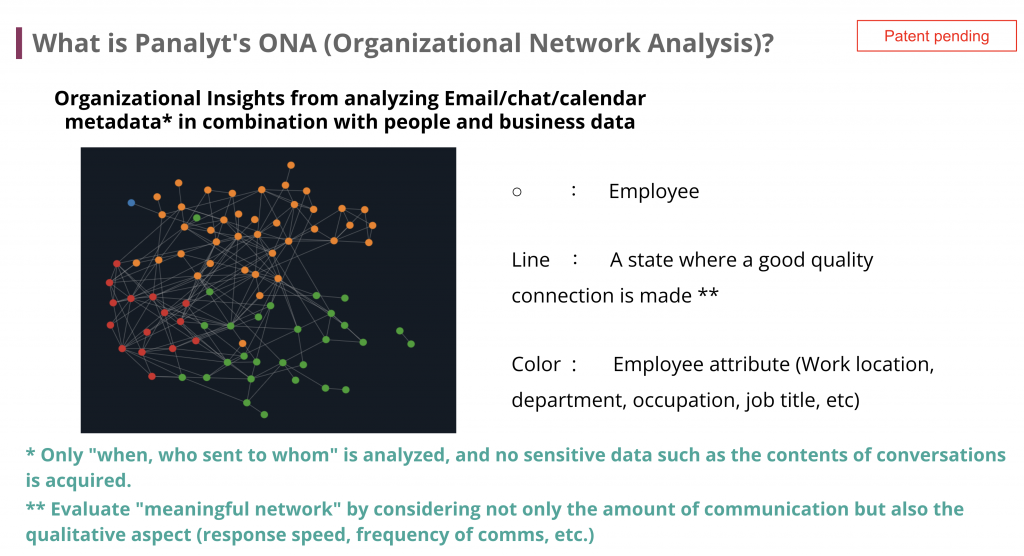
Interviewees
Panasonic Operational Excellence Co. , Ltd. Recruit & Career Create Center
● Takashi Sakamoto: Chief, Strategic Planning Division, Planning Department
● Shota Miyatani: Planning Department, Strategic Planning Division
● Yuka Shizuru, Planning Department, Strategic Planning Division
Table of contents
- Panasonic RCC Introduction and Current Organizational Development Focus Areas
- Insights Discovered with ONA
- Future Applications of ONA at Panasonic
- Feedback on Panalyt’s ONA Capabilities
- Additional Panalyt Reference Materials
Panasonic RCC Introduction and Current Organizational Development Focus Areas
(Titles omitted)
Tran:
Please tell us more about the Panasonic Recruit & Career Create Center (RCC). How has your department been affected by the group restructure?
Sakamoto:
RCC is mainly responsible for talent acquisition and career autonomy support for employees. Recruitment and Career Development were active as seperate departments until 2017, when they were merged together in anticipation of synergistic effects between the departments.
The Panasonic Group transitioned to a holding company system in April 2022, with several units that were in-house up to 2021 becoming independent as joint-stock companies. Panasonic Operational Excellence Co., Ltd. ( PEX), to which we belong, is one of the corporations.
The role of PEX is to align group employees across different fields on working together to contribute to the sophistication and efficiency of our customer’s operations; with customers in this case referring to operating companies within the Panasonic Group.
With this system change, it became necessary for RCC to change from a shared service provision department to a business entity that is exposed to a competitive environment with external companies.
Tran:
How would you like to transform the new RCC?
Sakamoto:
In addition to our prior focus on Talent Acquisition and Career Development, we would like to provide Total Human Resources solutions to realize the management strategy of the operating company and enhance the career journey of employees.
From a business entity that used to only passively respond to customer requests, we are now transforming into a business entity that proactively proposes human resources management strategies to achieve the desired management strategies of operating companies.
Tran:
What do you feel is the most important task in achieving that goal?
Sakamoto:
The Recruiting Department, which is responsible for talent acquisition, and the Career Create Department, which is responsible for supporting career development and autonomy, are the same as before the merger and the challenge lies in getting these two functions which have traditionally worked independently to start collaborating with each other. Until now, there was little co-operation and communications between departments, and potential synergies were not being realized.
At RCC, professionals from each field are gathered together, and we hope that they will not just focus on jobs in their specific fields, but also make use of each other’s strengths to innovate and create value for the organization; while realizing the opportunity to do more exciting work.
We need to embrace a new mindset as we have noticed a trend of high potential employees with a change mindset quitting because they don’t fit in well with a legacy organizational mindset.
Tran:
What kind of measures have you taken in the last 1-2 years to improve cross-team collaboration and what kind of results have you obtained in response to those goals and issues?
Sakamoto:
In order to enhance exchanges between the recruitment department, the career creation department, and our planning department, which used to work separately, we have taken measures to promote mutual understanding of the work content. We have also established a mission, vision, and cred for the entire RCC to increase organizational cohesion.
I feel that the middle managers are gradually interacting with each other through conscious efforts. However, I think that some managers have not yet placed great importance on the need for cross-departmental exchanges, and even if exchanges are born, the focus is on work that is completed in their own department, so skills and human resources There is no progress in mixing across departments in terms of aspects.
Tran:
You have been working on a pulse survey since last year, haven’t you? How did you originally start this?
Sakamoto:
It was introduced with the aim of improving communication between members with a relatively short tenure and managers, improving motivation in the process.
Going back to our goal of providing Total Human Resources solutions, it is essential for all members to take the initiative in thinking about improvements in new services and operations, but if they are not motivated, they will not take the initiative.
I think motivation will be a more important factor in RCC breaking the passive attitude of “doing only what you are told to do”
Tran:
What was the effect of introducing the pulse survey?
Sakamoto:
We get monthly feedback so that the manager can keep track of the members, but they haven’t done much to solve the issues revealed through the survey. Also, when reviewing survey results, we weren’t able to pinpoint the real issues accurately because the feedback was biased from the experience and feelings of the manager and employees. Therefore, we sought support from objective data.
Insights Discovered with ONA
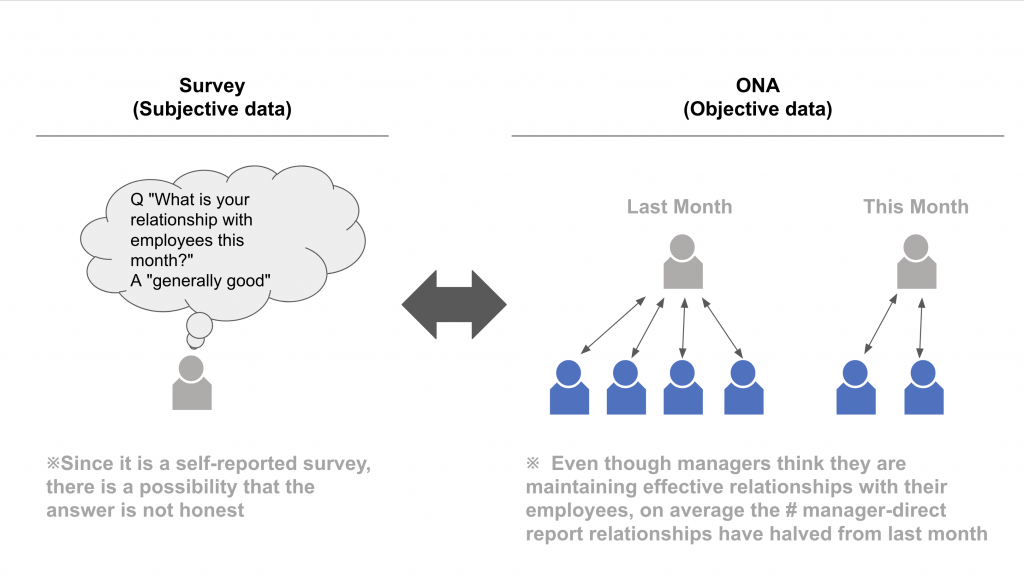
Tran:
I would like to ask about Organizational Network Analysis (ONA). What do you think has changed since the introduction of Panalyt’s ONA capabilities to provide “objective data backing” compared to the traditional pulse survey single approach?
Miyatani:
We can now very quickly validate a wide range of hypotheses about organizational issues.
For example, as an example of a subjective hypothesis, “An employee with low motivation in a pulse survey may not be able to interact with other employees and may be isolated.” Or conversely, ” employees who interact with many other employees have high motivation.”
However, the results actually visualized by ONA, we now observe that there are several employees who “look isolated but maintain high motivation“, or “have low motivation despite being in the center of the organization and interacting with many other employees including those from other departments“.
In the former case, if an employee can complete their work by interacting with just a few specific members, it is very easy to do the work as long as they are compatible with those members, so it may be possible to maintain high motivation.
On the other hand, in the latter case, the amount of communication increase due to having to interface with
other departments may have caused burnout and reduced motivation.
With ONA, we are now able to objectively analyze events that could be misinterpreted by looking at self-reported surveys in isolation.
With ONA, we are now able to objectively analyze events that could be misinterpreted by looking at self-reported surveys in isolation.
Tran:
It means that subjectivity could not be completely eliminated with only the pulse surveys.
Miyatani:
Yes. In addition, managers were only able to have a grasp on their relationships with their direct reports; but they were unaware of the work their team members were doing in collaboration with members from other departments – making it impossible to notice signs of collaboration overload that can lead to burnout unless the employees speak out themselves.
Being able to visualize communication that the manager is not directly involved in will also help identify the cause of the problem.
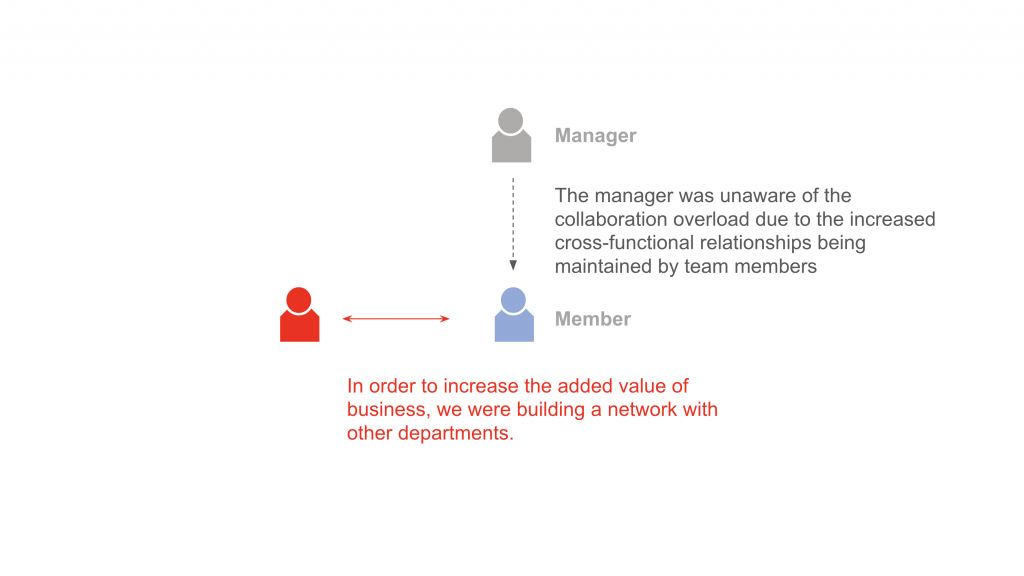
Tran:
So you found that managers are unaware of the internal networks being maintained by their team beyond the scope of their involvement. This must have been even more difficult since the coronavirus due to an increase in online exchanges as your organization embraced a remote, and then hybrid work style.
Did you find any other stereotypes overturned?
Miyatani:
Naturally thinking, we assumed that the better the managers have relationships with their members, the more likely the members meet expectations of their roles and responsibilities from their managers. However, the ONA results didn’t necessarily follow that intuition.
Even though the frequency and reciprocity of the communication between managers and members seem healthy, we may have to investigate the contents of conversations.
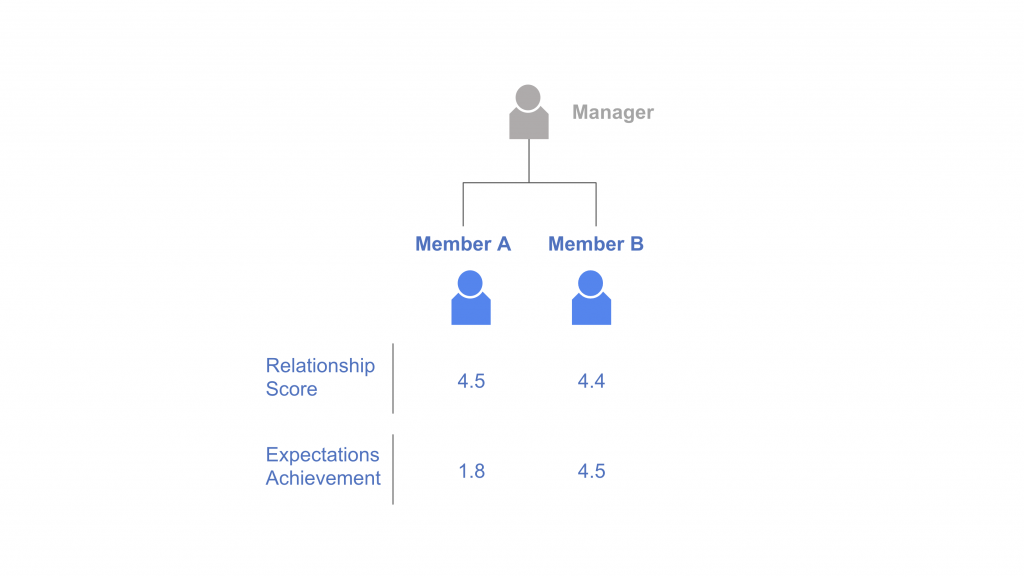
Tran:
There was also a finding that managers with many horizontal and diagonal connections had a higher innovation mentality than managers who do not. It is often said in innovation theory that employees with a stronger “Know Who”, i.e. social capital, are more likely to contribute value than employees with a stronger “Know How” and this was a result that partially supported it.
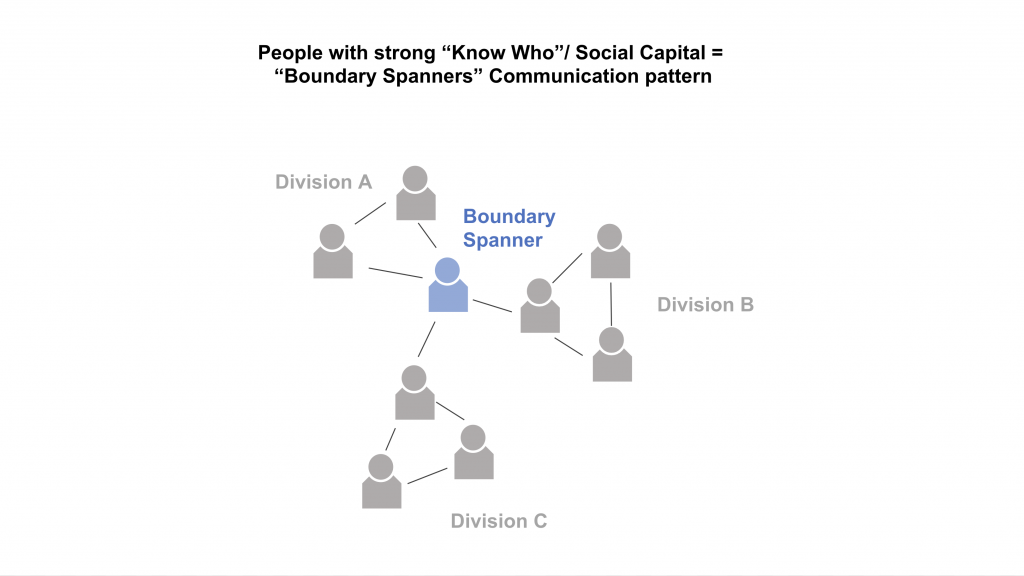
Sakamoto:
ONA allows us to understand if and how managers are developing relationships with their team members, not just employees directly under their control; but also with other junior employees not directly reporting to them. It’s hard to say in a nutshell, but we believe the latter can also be an indicator of the manager is taking the time to mentor those members, not in their teams and not involved in their immediate scope of work.
While some connections might seem unnecessary from a business/ work perspective at first glance, we can now investigate a wide range of hypotheses such as – “ is X a good mentor? Is Y facilitating inter-departmental collaboration? Is Z actually a key person involved in running the organization smoothly but neither his team members nor the manager is aware of this?”
Tran:
It is interesting. I think the ideal way to use ONA is to get the next hints for organizational and human resource development from the actions and connections of people who behave differently than expected, in a good way.
Sakamoto:
However, if you don’t guide the way you look at the data well, I don’t think it will lead to valid results. There is no uniform and versatile usage, and I think that it is data that can lead to bias if you are not good at it. After understanding the dangers, I feel that it is necessary for us to constantly improve the way data is used.
Tran:
True – because the “facts” that can be seen from the data and the “truths” that should be read from them and utilized in measures are different, it is important to deepen the discussion while looking at the common language of objective data.
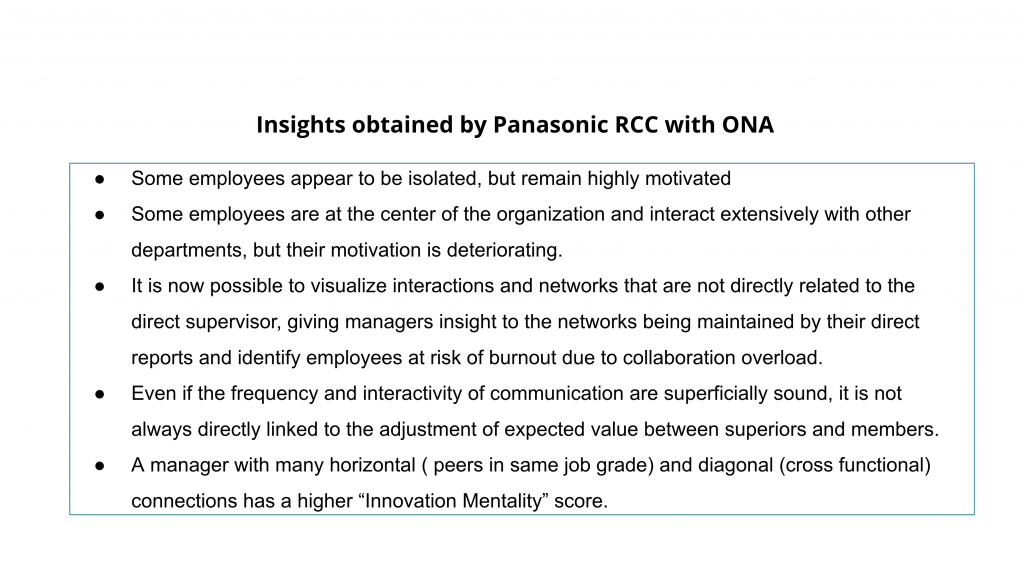
Future Applications of ONA at Panasonic
Tran:
Are there any other issues or themes that Panasonic RCC would like to work on using ONA in the future?
Sakamoto:
We wish to improve the quality of communication, and for this, we wish to leverage ONA to help managers improve their communication skills.
Quality here refers to the satisfaction of the team members – for eg. after a 1-1, we can provide a simple questionnaire along the lines of” Did the manager listen to your story properly?”, and this in conjunction with understanding response rates, communication frequency and relationship strengths from the ONA data can help us visualize and analyze these communication skills.
Some managers may be confident in their communication skills. However, if you are satisfied, you cannot expect further growth. By showing objective data to the manager, I think it will be an opportunity to think about how to improve the relationship with their team members.
Shizuru:
In order to improve the quality of relationships between managers and team members, it is important for the manager to be familiar with each team member and to communicate properly with them.
Deploying a pattern of communication to team members for all managers doesn’t help as managers need to change communication to suit each individual employee; where preferences can be very diverse.
Miyatani:
For example, we have observed that even if a group of employees experiences a similar change in relationship score, the effect on motivation is different for each person.
By continuously looking at ONA and pulse surveys, we can infer why the difference was made and the values of the person. By knowing the individual members, the manager may be able to communicate better.
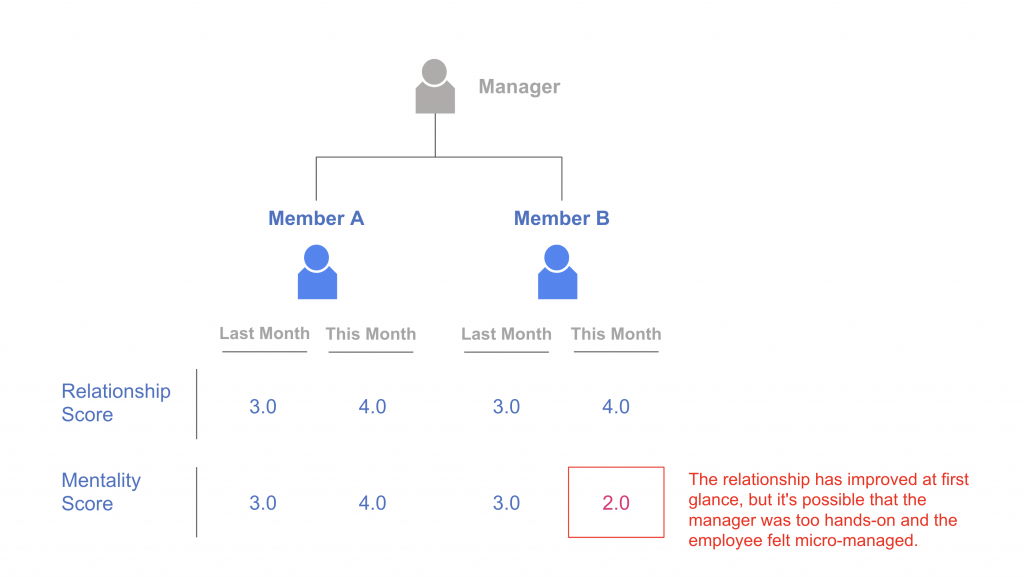
Tran:
The managerial approach from the manager to the team members should be different and personalized for each member. I think it makes sense to continuously observe ONA data at fixed points to get objective information can be highly effective in assessing such behavior.
Sakamoto:
In addition to being a tool for managers to see their relationships with their team members and the internal networks formed by their teams, I would like to leverage ONA as a tool for managers to learn management techniques/styles from each other.
There aren’t many companies that have achieved this yet, but I think every manager needs to have a coach. There are several variations in management style, and there might be some managers who have not yet learned how to effectively manage within a specific wider culture – so I would like to create a system where managers can learn from each other.
ONA is a very powerful tool that allows us to objectively see and use the relationships between employees as indicators for understanding and improving managerial effectiveness.
In addition, I would like to use this as an opportunity to increase the horizontal (and cross-functional ) connections between employees. Sometimes connections made by managers between two members are not successful, and in this case, the manager should be able to intervene and remove the barriers to the desired relationship. ONA can help us in identifying such psychological hurdles.
Tran:
There is also the possibility that the manager thinks – “In order to facilitate the work of a member, I should connect with this person in another department,” but from the results of ONA, there is a possibility that there are other people who are more suited to facilitating cross-functional collaboration.
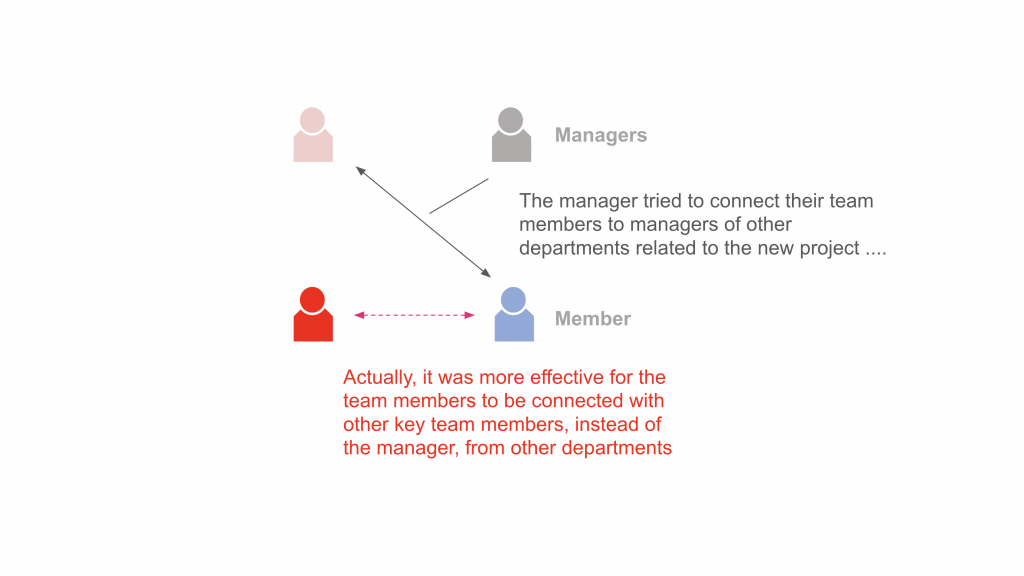
Sakamoto:
ONA is a revolutionary asset for deliberately designing connections between employees.
Social capital is an asset, and in most cases, the more you have, the better. We believe that managers with less social capital rising above the organization can lead to a sudden decline in organizational strength. ONA allows us to visualize and understand the connections between employees and intentionally design them so as to not reduce the organizational strength.
Our work is very different from manufacturing, and it’s not easy and mechanical to hand over the work to the next person as soon as you make and hand over a manual. Connections with people are an important aspect of succession planning and onboarding, and ONA is a tool that can be used for both planning and checking connections.
Tran:
Looking at the previous research on how to utilize ONA, most of them are focused on checking (understanding the current situation). It is a very advanced attempt to utilize it for planning and design, at least as of 2022.
Sakamoto:
We would like to continue to see what happens to the relationships with other employees when the manager is placed in a new position. ONA indicators – such as the # of relationships and strength of relationships- can add an additional perspective to our annual 360-degree evaluations.
We can check if people are connected to the right people for their roles, and also if managers are able to fulfill their roles to connect their team members with the right resources.
We would also like to use ONA data to redefine JD ( job descriptions ) and missions.
Tran:
How would you like to involve the management and other department managers?
Miyatani:
In order to create a state where we can discuss these measures while looking at the data together and interpreting it, we would like to first consider the ONA data of Panasonic RCC as a pilot case and then work with the Panalyt team to strategize as a wider approach.
Using ONA to support the actions of the management team and department managers for the use cases mentioned earlier will improve utility and adoption. However, we do need to be mindful of reducing the bias mentioned by Mr. Sakamoto in the first half and will require support in considering the correct method for interpreting ONA data and designing action plans based on the insights.
Sakamoto:
It’s a very good action plan. I would like to continue the ONA analysis with Panalyt in order to design intentional changes to improve organizational effectiveness.
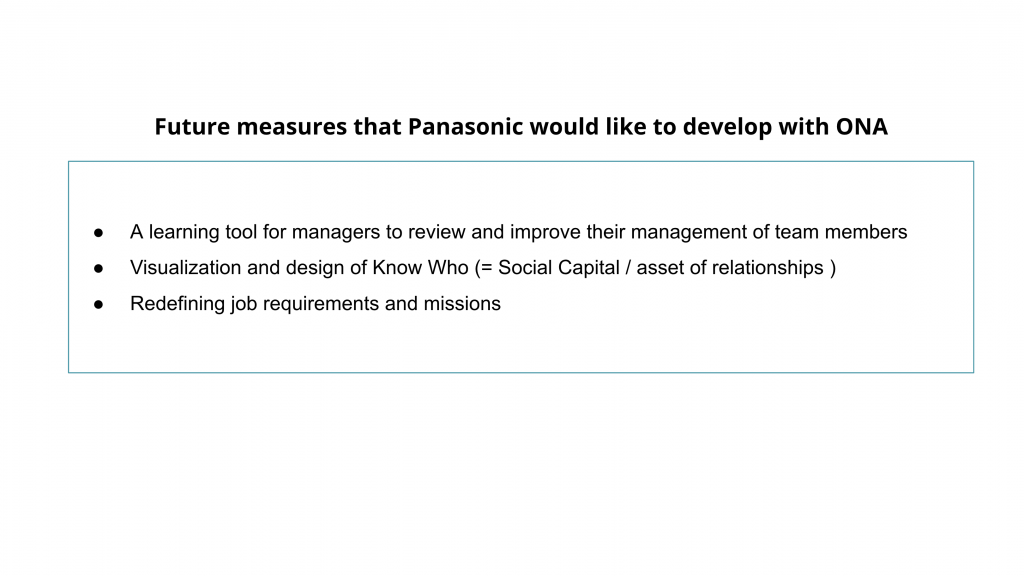
Feedback on Panalyt’s ONA Capabilities
Tran:
How has your experience been while using Panalyt’s ONA tool?
Miyatani:
When you hear network analysis, the hurdles may seem very high but that’s not been the case at all with Panalyt.
The UI (user interface) is very intuitive. For example, if you want to filter by a specific employee attribute to narrow the reference range, you can understand what to do without a manual.
Moreover, the graph itself is very easy to understand because it has a simple structure of nodes that represent humans and edges that represent connections; and we can layer any attribute/ dimension on top of the graph for improved understanding.
Tran:
Thank you everyone for your valuable story today!
Additional Panalyt Reference Materials
Panalyt helps bridge the People-Data Gap, operationalizing the delivery of relevant, timely, accurate and integrated data, insights and reports across the employee lifecycle, including data on employee connections & relationships, for any combination of HR, business line, or C-suite.
These people-informed decisions drive an improved HR and business-line relationship, moving from reactive to proactive around people, data, analytics and aligned decisions and utilize people data to drive organizational performance and results.
Download Panalyt Overview Deck
Panalyt’s ONA capabilities provide a lens into how work really gets done at your organization by mining behavioural insights from internal and external employee communication and collaboration metadata.
These behavioral patterns are then presented in clear intuitive dashboards and reports for business leaders, co-related with desired business outcomes like increased productivity and innovation, higher engagement and wellness, and reduced attrition, to enable you to nudge your employees to adopt desired behaviors to help them succeed in their roles.
The Panalyt team has curated a list of resources that deep dive into different use cases for ONA for you!
Predicting Attrition Risk and Understanding Drivers
Practical Business Applications of Relational Analytics
Key Questions answered with Relational Analytics for WFH Effectiveness
Breaking Biases with People Analytics and Relational Analytics (ONA)
Accelerating Advancement of Diverse Talent with People Analytics & Organizational Network Analysis



